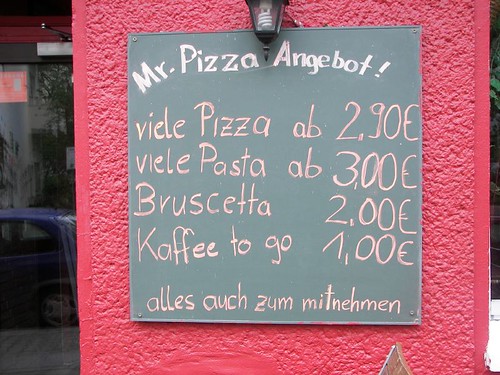Kaffeepause At A German Cafe Posted by Constanze on May 27, 2015 in Culture, Language
Anyone who visits Germany will inevitably end up in a coffee shop at some point during their travels, so I thought I’d put together a list of phrases you can use to navigate your way through a German café. For convenience’s sake the café in this scenario is one where you order and pay at the counter, though the conversation will be practically the same if in a café with table service.
Remember that the other customers and staff in the café are strangers, so you use the formal way of addressing them (‘Sie’ rather than ‘du’).
When you go up to the counter, greet your Verkäufer(in) (cashier) with a: Guten Morgen! / Guten Tag!
Good morning! / Good day!
Now order your drink like this: Einen Kaffee, bitte. / Einen Tee, bitte. / Eine heiße Schokolade, bitte.
A coffee, please. / A tea, please. / A hot chocolate, please.
If you’re taking away, you add zum mitnehmen onto your sentence: Einen Kaffee zum mitnehmen, bitte. / Einen Tee zum mitnehmen, bitte. / Eine heiße Schokolade zum mitnehmen, bitte.
A coffee to go, please. / A tea to go, please. / A hot chocolate to go, please.
As you can see from the sign above, Germans have also adopted the English term ‘to go’ in place of ‘zum mitnehmen’. However, they often write it twice, once in English and once in German, as if Kaffee To Go is the drink’s official name, and they then need to clarify that a Kaffee To Go can also be taken away. The result sounds ridiculous to an English speaker (‘Coffee to go – everything also to go’). This sign is not a one-off, either!
*The confusion about German coffees*
Furthermore, German coffee names are a little confusing. While a Milchkaffee (‘milk coffee’) might sound like a regular filter coffee with milk, it’s actually half a cup of filter coffee topped up with hot milk. If you want a coffee with cold milk, you need to ask for ‘Kaffee mit Milch’, after which you’ll most likely be served a cup of black coffee, and add the Milch or Sahne (cream) yourself. Meanwhile, a Latte Macchiato might cause confusion if ordered in an English café, but in Germany this is a common coffee served in a tall glass, and consisting of hot milk, espresso and foam. This is different to both a Latte and a Macchiato as we know them. Yes, it’s all a bit confusing! But Filterkaffee (filter coffee) is very popular in Germany, and is usually very good (read: strong), wherever you go. If you’re not sure what to get, but don’t want to end up with a Milchkaffee or any other foamy drink, ask for a Filterkaffee, or just a Kaffee.
Once you’ve got your drink your server may ask you: Sonst noch was? / Noch etwas dazu?
Anything else? / Anything else with it?
Reply if you want nothing else: Nein, danke. Das ist alles.
No, thanks. That’s everything.
If you want to know if the café serves a certain thing, you can use this sentence:
Haben Sie …? Do you have …?
Or if you want to know what types of things they have (eg. teas), you can ask:
Was für … haben Sie? What kind of … do you have?
*For things you could ask for, like lactose-free milk, decaf coffee, etc. see the list at the end of this post.*
Your server will then tell you how much it comes to. Remember that number order is different in German to how it is in English, so if the price of your coffee is 2,45 it will be said like this: Zwei Euro fünfundvierzig, bitte. ‘Two Euros five and forty, please’. Well, hopefully you’ll be able to see the price on the till display at this point, but you never know!
When you go to sit down, you may need to ask another customer: Ist dieser Stuhl frei?
Is this chair free?
They may reply with: Ja, Sie können Sich hinsetzen.
Yes, you can sit here.
Or they may reply with: Nein, er ist besetzt. / Nein, hier sitzt jemand.
No, it’s occupied. / No, someone’s sitting here.
You may need to ask for the toilet at some point. Do this by saying: Wo sind die Toiletten, bitte?
Where are the toilets, please?
Now, the all-important question! Gibt es WiFi hier?
Is there WiFi here?
Make sure you get the password right by asking your server to do this: Können Sie mir bitte das WiFi Passwort aufschreiben?
Could you please write the WiFi password down for me?
Work done and coffee finished, the café staff will more than likely acknowledge you as you leave. Thank them with a friendly: Vielen Dank! Auf Wiedersehen!
Thank you! Goodbye/Until next time!
This is about the extent of the phrases you need to get by for a simple, quiet Kaffeepause at a German café. Was kann schöner sein? 🙂
Many thanks to Marcus at the Swedish blog for giving me the idea for this post! If you want to learn all of this in Swedish, too, click here for Marcus’ very helpful post.
Bis bald!
Constanze x
Related vocabulary
Coffee break – Die Kaffeepause
Coffee beans – Die Kaffeebohnen
Caffeine-free – koffeinfrei
Decaf coffee – Der entkoffeinierter Kaffee
Herbal tea – Der Kräutertee
Soya milk – Die Sojamilch
Almond milk – Die Mandelmilch
Lactose-free milk – Die laktosefreie Milch
Allergy – Die Allergie
Cream – Die Sahne
Sugar – Der Zucker
Sweetener – Der Süßstoff
Napkin – Die Serviette
A glass of water – Ein Glas Wasser

Build vocabulary, practice pronunciation, and more with Transparent Language Online. Available anytime, anywhere, on any device.
About the Author: Constanze
Servus! I'm Constanze and I live in the UK. I'm half English and half German, and have been writing about German language and culture on this blog since 2014. I am also a fitness instructor & personal trainer.







Comments:
Transparent Language:
Comment via email:
When I lived in Germany in the 60s*, I learned of “Blumenkaffee.” This is when you can see the flowers at the bottom of the china cup through the coffee, referring to a very weak brew. Was this perhaps just a regional use, or was it broader?
Thank you so much for this blog. I am heartened that although I may never have heard or seen a word or phrase, I still instantly understand it in context in your blog. I dearly loved learning and speaking German, and continue to look for opportunities to keep learning.
Warmly,
Martha Meyer Osgood
Eugene, Oregon
* including one year in the Humanistisches Gymnasium, Zweite Klasse, Amberg.
Pat Crookes:
i was staying in Aachen last year and while in a cafe the first morning a stranger told me about the deposit system for cups. I was surprised when I got 2 euro back from the assistant. Each time I was in. Cafe after that I checked the receipt to see if there was a deposit.
I enjoy your blog and try to read it each month.
Constanze:
@Pat Crookes Thanks for the comment, Pat! I’ve never experienced this in a cafe, but it’s quite a common thing in Germany (it’s called Pfand) so I’m not surprised! Glad you like the blog. 🙂
Alcazar:
Blumenkaffee or Blümchenkaffee is mostly used in Saxony, because of the porcelain manufatory in Meißen.
In other regions its called Plörre, which is a general description for bad drinks (i. e. beer).
Jenna:
Just discovered this blog and have read multiple entries in one sitting — very well done, Constanze! I lived in Germany for almost three years (two in Karlsruhe and one in Wolframs-Eschenbach). I became “hooked” on going to cafes and miss them very much. (I was too young to be a Kaffeetante, but I was one in every other sense! 🙂 I learned a variation on “Ist dieser Stuhl frei?” that was simply, “Is hier frei?” No biggie, but always fun to have options. Well, I’m subscribed now and am looking forward to future articles!
Constanze:
@Jenna Hi Jenna, thank you so much for your lovely comments! Apologies for my late reply- I read my comments on the go and save the replies for later on, when I have a chance to reply properly. 🙂 As you pointed out, there are many ways of saying the same thing, and it’s perfectly acceptable to say “Ist hier frei?”, too! In English we shorten phrases all the time, and it’s the same in German. Enjoy the rest of the blog! 🙂 Constanze x
Jenna:
I forgot to mention, Constanze, my maiden name is Arnold! Maybe we’re distant cousins! Who knows!!
Keith Duncan:
Do you have to ask for the cream and sugar at the counter when you order your coffee or is there a dispenser counter like in most American walk up counter restaurants…
Crystal:
Thank you for this blog! I found it very helpful now if you’ll excuse me…. am on my way out for a cup of coffee 🙂
Constanze:
@Crystal Haha that’s exactly how I felt when I wrote this post. 😉 Glad you found it helpful!! Constanze x
Bettina:
I just discovered this blog because I made myself some Milchkaffee and wondered if there is any other country in the world where they actually like scalded milk combined with coffee except for Germany. I giggled a lot reading the article! However, one thing that popped into my mind: Germans don’t say “WiFi”, they say “WLAN” (“vee-lahn”).
So, I’d ask “Gibt es WLAN hier?” and “Können Sie mir bitte das WLAN-Passwort aufschreiben?”.
[But don’t be surprised if they don’t because Germany gets the short straw when it comes to mobile internet connectivity. There is no extensive public WiFi coverage and we *still* don’t have unlimited data plans. (Try living with 500 MB/month while being a very active instagrammer…sigh.)]
Bettina:
edit: “ve-lahn”, not “vee-lahn”, with an “e” as in “let” 🙂 I’m sorry for my mix-up
Todd:
I have a question. When I was in Augsburg (in Southern Germany) and ordered a coffee at any bakery (about the only spot to get one) they where made on the espresso machine, with what looked like a double shot amount of ground coffee, tamped like an espresso. They place the cup under the spout, push a button on the machine and make the coffee directly into the cup. The large is much smaller than our small in North America, but much more than a long shot. I’m guessing about 6 ounces. It’s not an Americano, although they are available. There is always a good amount of crema on the top. What is this? Thanks.